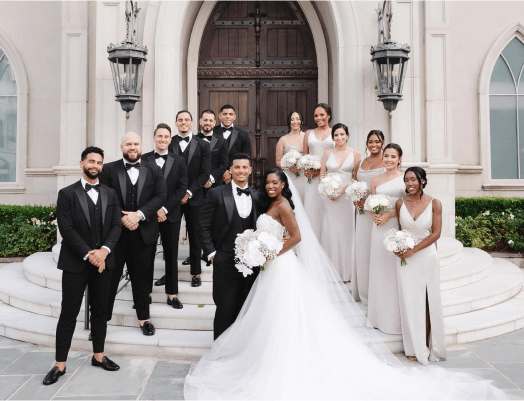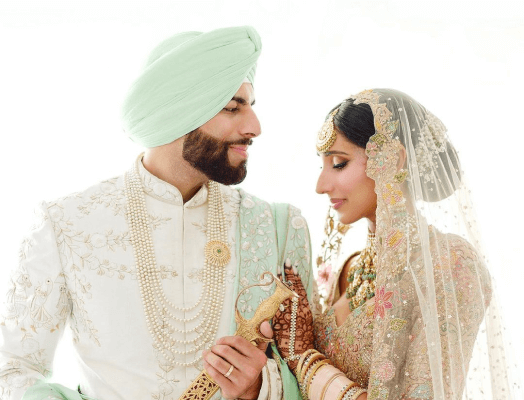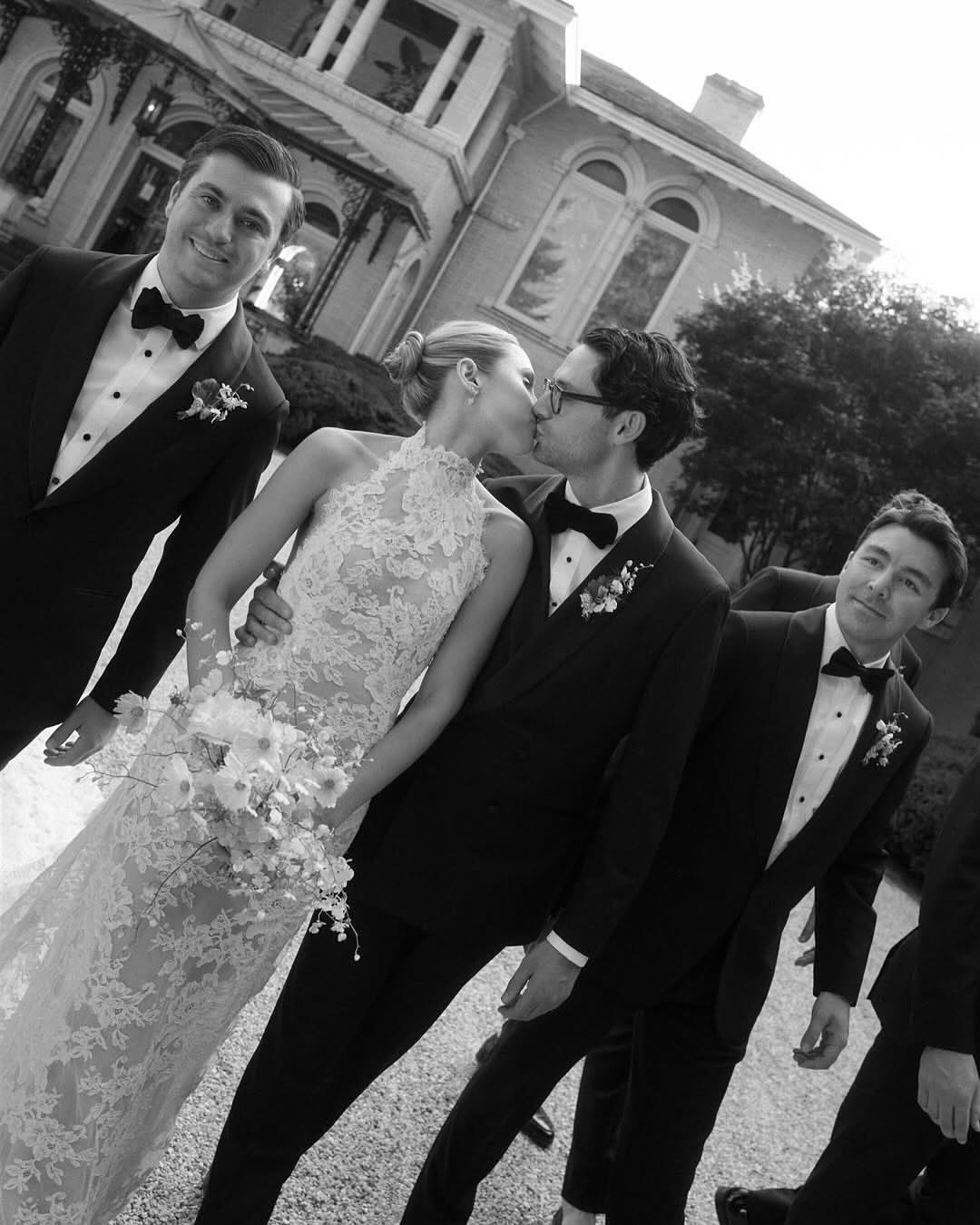What You Need To Know About Creating A Wedding Menu
- Author: Natali Grace Levine
- Reading time: 11 min 0 sec
- Publication date: 08/18/2025
- Updated: 08/21/2025
Your wedding menu is far more than a simple collection of dishes—it's a culinary love letter that tells the story of your relationship and sets the emotional tone for one of life's most cherished celebrations. Every bite should reflect your personalities, honor your heritage, and create lasting memories for both you and your guests. The art of creating wedding menus lies in thoughtful planning, meaningful personalization, and careful attention to the details that transform a meal into an unforgettable experience.
A well-designed wedding menu becomes a conversation starter, a memory maker, and a reflection of the care you've put into every aspect of your special day. It's an opportunity to share your favorite flavors, celebrate your cultural backgrounds, and ensure that every guest feels welcomed and considered. The choices you make—from the opening appetizer to the final sweet bite—will become part of your wedding story, remembered and discussed for years to come.




Find Your Perfect Wedding Vendors
How to Create Your Own Wedding Menu: Understanding the Basics
Before diving into the creative aspects of menu design, it's essential to understand the fundamental components that form the backbone of any successful wedding dining experience. These foundational elements will guide every subsequent decision, from budget allocation to timeline planning, ensuring your culinary vision translates seamlessly into reality.
Defining Your Wedding Menu Style
The foundation of your wedding menu begins with choosing the service style that best aligns with your vision, venue, and guest experience goals. Each approach offers distinct advantages and considerations that will shape your entire dining experience.
Plated Dinners represent the pinnacle of formal elegance, with professionally presented courses served directly to each guest. This style ensures consistent presentation, allows for precise portion control, and creates an upscale restaurant-quality experience. The primary advantages include guaranteed temperature control, beautiful plating aesthetics, and the ability to accommodate individual dietary restrictions with specific meals. However, plated service typically requires a higher per-guest cost due to increased staffing needs and may limit menu variety since guests usually choose from predetermined options.
Buffet Service offers unparalleled variety and cost-effectiveness, allowing guests to sample multiple dishes and control their own portions. This style works exceptionally well for casual celebrations, cultural events with diverse cuisine options, or large gatherings where budget considerations are paramount. Buffets encourage mingling as guests move through serving areas and can accommodate various dietary preferences through diverse offerings. The potential drawbacks include challenges with food temperature maintenance, possible crowding during service times, and less formal presentation.




Family-Style Dining creates an intimate, communal atmosphere reminiscent of holiday gatherings, with large platters placed at each table for guests to share. This approach:
- Fosters conversation and connection
- Reduces service time and staffing needs
- Often feels more personal and welcoming
- Works beautifully for rustic or casual weddings
- Can be more cost-effective than plated service
Food Stations combine the variety of buffets with the sophistication of specialized preparation, featuring different culinary themes or cooking styles at separate locations throughout your venue. Benefits include:
- Creating natural flow throughout your reception space
- Allowing for interactive experiences with chefs
- Providing entertainment value as guests explore options
- Accommodating various dietary preferences simultaneously
- Offering opportunities for themed presentations
Essential Components of a Wedding Menu
Understanding the traditional structure of wedding menus provides a framework for creating your perfect dining experience, though modern couples increasingly customize these elements to reflect their unique preferences.
Appetizers serve as the welcoming gesture of your culinary journey, setting expectations and creating the first taste impression. Passed hors d'oeuvres during cocktail hour allow guests to mingle while enjoying bite-sized delicacies, creating an elegant and social atmosphere. Stationed appetizers, arranged on tables or buffet areas, provide more substantial options and can include items that require utensils or are more filling. Consider incorporating a mix of hot and cold options, ensuring there are choices that accommodate various dietary restrictions and preferences.
Main Courses represent the centerpiece of your wedding menu, typically featuring protein options paired with complementary sides. Traditional approaches include offering guests a choice between chicken, beef, fish, or vegetarian entrees. Modern trends lean toward offering multiple smaller portions, allowing guests to sample different proteins, or creating themed stations that reflect specific cuisines or cooking styles.
Sides and Salads provide balance to your menu, adding fresh elements, different textures, and nutritional variety. Seasonal vegetables, grain-based salads, and fresh greens not only complement your main courses but also ensure vegetarian and health-conscious guests have satisfying options. Consider how these elements work together to create a cohesive flavor profile while providing visual appeal through different colors and presentations.
Desserts have evolved far beyond traditional tiered wedding cakes, though many couples still choose to include cake alongside additional sweet options. Modern dessert presentations might include dessert tables with various small treats, interactive stations like s'mores bars or ice cream sundae setups, or themed dessert experiences that reflect your personalities or interests.
Beverages encompass everything from signature cocktails that tell your story to carefully selected wine pairings that enhance each course. Consider creating drinks that represent significant moments in your relationship, incorporate family recipes, or reflect the cultural traditions you want to honor. Don't overlook non-alcoholic options, ensuring designated drivers, non-drinkers, and younger guests have appealing choices throughout the celebration.




Creating a Wedding Menu That Resonates
When you create a wedding menu, you're not simply choosing meals; you're curating a moment that reflects your personalities and enhances the celebration.
Infusing Personal Touches
The most memorable wedding menus tell a story, weaving together the couple's shared experiences, cultural backgrounds, and favorite flavors into a cohesive culinary narrative. Personal touches transform a standard catering menu into something uniquely yours, creating talking points and emotional connections for both you and your guests.
Consider incorporating dishes that represent significant moments in your relationship through these approaches:
- First Date Memories: Include cuisine from your first date restaurant or recreate the dish you shared
- Travel Adventures: Feature foods from destinations you've explored together
- Cultural Heritage: Honor both families' traditions through authentic dishes or fusion creations
- Home Cooking: Incorporate family recipes that have shaped your lives
- Shared Passions: Reflect hobbies or interests, like craft beer pairings for brewing enthusiasts
Cultural fusion can beautifully represent couples from different backgrounds, creating menus that honor both traditions while celebrating your union. This might mean serving both traditional American wedding fare alongside authentic dishes from your partner's heritage, or creating fusion dishes that blend different culinary traditions in creative ways.
Embracing Seasonal and Local Ingredients
Designing your menu around seasonal availability ensures peak freshness and optimal flavors while supporting your local agricultural community. Each season offers unique opportunities:
Spring Celebrations (March - May):
- Fresh asparagus and tender greens
- Early strawberries and rhubarb
- Herbs like chives, dill, and early basil
- Spring lamb and fresh seafood
- Light, renewal-themed presentations
Summer Weddings (June - August):
- Peak-season tomatoes and fresh corn
- Stone fruits like peaches and nectarines
- Berries at their sweetest
- Fresh herbs and edible flowers
- Grilled and lighter preparation styles
Fall Receptions (September - November):
- Root vegetables and winter squashes
- Apples, pears, and cranberries
- Heartier proteins and warming spices
- Rich, comfort-food presentations
- Harvest-themed aesthetic opportunities
Winter Celebrations (December - February):
- Brussels sprouts and winter root vegetables
- Citrus fruits at their peak
- Rich, warming dishes and stews
- Preserved and pickled elements
- Cozy, intimate presentation styles
Working with seasonal and local ingredients requires flexibility and collaboration with your caterer, but the results often exceed expectations in terms of flavor, presentation, and overall experience. Your caterer can guide you toward the best options available during your wedding season and help you understand how to substitute ingredients if certain items become unavailable.
Catering to Dietary Preferences and Restrictions
Modern wedding planning requires thoughtful consideration of diverse dietary needs, ensuring every guest feels welcomed and able to fully enjoy the celebration. Success lies in creating inclusive experiences where restrictions don't feel like limitations.
Essential Dietary Considerations:
- Vegetarian and vegan preferences
- Gluten-free requirements
- Food allergies (nuts, shellfish, dairy)
- Religious dietary laws (kosher, halal)
- Cultural food preferences
- Medical dietary restrictions
Strategies for Inclusive Menu Planning:
- Start with Information Gathering: Include dietary questions in your RSVP process
- Create Substantial Options: Design complete, satisfying meals rather than afterthought alternatives
- Think Naturally Inclusive: Choose dishes that are inherently gluten-free, dairy-free, or vegetarian
- Label Everything Clearly: Provide detailed information at buffets and stations
- Plan for the Unexpected: Always prepare more alternatives than specifically requested





Wedding Menu Ideas: Presentation and Aesthetics
The visual presentation of your wedding menu extends far beyond the food itself, encompassing everything from elegant menu cards that guests take home as keepsakes to creative displays that enhance your venue's ambiance. These design elements serve both functional and decorative purposes, guiding your guests through the dining experience while reinforcing your wedding's overall aesthetic theme.
How to Create a Wedding Menu Card
Menu cards serve as both functional guides and decorative elements that complement your wedding's visual theme. These pieces become keepsakes for many guests, making thoughtful design investment worthwhile. Here’s how to make your own wedding menu cards.
Typography Considerations:
- Romantic Traditional: Elegant script fonts for classic celebrations
- Modern Minimalist: Clean sans-serif options for contemporary events
- Rustic Charm: Vintage-inspired typography for barn or outdoor weddings
- Playful Fun: Creative fonts for casual, personality-driven celebrations
- Readability Priority: Ensure legibility at your selected size for all guests
Design Elements That Matter:
- Color Harmony: Coordinate with wedding palette while ensuring readability
- Contrast Importance: Use sufficient contrast between text and background
- Metallic Accents: Consider gold foil or silver printing for luxury touches
- Layout Hierarchy: Organize information logically with proper spacing
- Material Quality: Choose durable cardstock that maintains appearance throughout the evening
Content Structure Guidelines:
- List courses in serving order
- Provide brief descriptions for unfamiliar dishes
- Include dietary restriction indicators
- Maintain consistent formatting
Displaying Menus Creatively
Beyond individual menu cards, creative display options enhance your venue's ambiance while providing practical information about your dining experience. These displays become integral parts of your reception's visual landscape.
Chalkboard Presentations:
- Flexibility for last-minute changes
- Opportunity for decorative flourishes
- Perfect for outdoor or barn venues
- Cost-effective and reusable
Framed Prints:
- Elegant, formal presentation style
- Multiple size options available
- Easy positioning on easels or walls
Digital Displays:
- Dynamic presentations possible
- Easy real-time updates
- Ideal for tech-forward couples
Acrylic or Glass Displays:
- Clean lines and modern aesthetic
- Excellent photography properties
- Can incorporate lighting effects
- Weather-resistant for outdoor use
Creative Alternatives:
- Vintage mirror writing with calligraphy
- Wooden signs with engraved text
- Fabric banners with custom printing
- Botanical displays with menu integration
- Interactive tablet stations for tech-savvy celebrations




Innovative Wedding Menu Ideas to Delight Your Guests
Moving beyond traditional wedding fare opens doors to memorable experiences that engage your guests and reflect your personality as a couple. These innovative approaches transform dining from a passive activity into interactive entertainment, creating talking points and Instagram-worthy moments that elevate your entire celebration. The key lies in balancing creativity with practicality, ensuring your unique choices enhance rather than complicate your special day.
Unique Appetizer Stations
Elevating your appetizer experience beyond passed hors d'oeuvres creates memorable first impressions and sets an innovative tone for your entire reception. Interactive stations engage guests while providing substantial options that satisfy varying appetites.
- Caviar and Blini Bar: Luxurious spreads with traditional accompaniments
- Poke Bowl Station: Fresh fish with customizable toppings and sauces
- Dim Sum Cart Service: Authentic steamed dumplings served tableside
- Antipasto Grazing Tables: Italian-inspired spreads with cured meats and pickled vegetables
- Ceviche Bar: Fresh citrus-cured seafood with tropical garnishes
- Hummus and Mediterranean Mezze: Multiple hummus flavors with warm pita and vegetables
- Empanada Station: Baked pastries with various savory fillings
- Korean BBQ Lettuce Wraps: Interactive wrapping with marinated meats
- Gazpacho Shooters: Chilled soup shots in elegant glassware
- Artisan Pickle Bar: House-made pickled vegetables and unique brines
- Mini Lobster Roll Station: Bite-sized versions of the classic sandwich
- Escargot and French Classics: Sophisticated European appetizers
- Vietnamese Spring Roll Bar: Fresh rolls assembled with chosen fillings
- Smoked Salmon Bagel Station: Everything bagels with premium toppings
- Stuffed Mushroom Varieties: Multiple preparations from different culinary traditions




Interactive Main Course Options
Main course stations involving guest participation or chef interaction create memorable experiences that extend beyond simple dining. These options encourage mingling while accommodating diverse preferences and dietary needs.
- Ramen Bar: Customizable broths, noodles, and toppings for personalized bowls
- Pho Station: Vietnamese soup with fresh herbs and condiments
- Hibachi Grill: Teppanyaki-style cooking with theatrical presentation
- Falafel and Mediterranean Wrap Station: Fresh preparations with tahini and vegetables
- Korean Bibimbap Bar: Rice bowls with marinated vegetables and proteins
- Indian Curry Station: Multiple curry options with naan and rice varieties
- Seafood Boil Setup: Communal-style dining with corn, potatoes, and shellfish
- Pierogi Bar: Polish dumplings with savory and sweet filling options
- Shawarma Station: Middle Eastern carved meats with fresh accompaniments
- Thai Noodle Station: Pad Thai and other stir-fried noodle preparations
- Brazilian Churrasco: Rotating meats carved tableside with chimichurri
Creative Dessert Alternatives
While traditional wedding cakes remain beloved, couples increasingly explore creative dessert options that better reflect their personalities and provide more interactive, memorable experiences for their guests.
- Ice Cream Sundae Bars: Multiple flavors, premium toppings, creative mix-ins
- S'mores Stations: Outdoor fire pits or indoor warming stations
- DIY Cookie Decorating: Pre-baked shapes with icing and decoration supplies
- Churro Bars: Fresh preparation with multiple dipping sauces
- Cotton Candy Stations: Live spinning with flavored sugars
- Donut Walls: Instagram-worthy installations with artisanal varieties
- Dessert Towers: Multi-tiered displays of petit fours and mini desserts
- Candy Buffets: Color-coordinated selections in elegant containers
- Macaron Displays: French elegance with seasonal flavors
- Cupcake Gardens: Artistic arrangements with varied decorations
- Dessert Flights: Tasting portions of multiple sweets, wine-pairing style
- Liquid Nitrogen Ice Cream: Dramatic preparation with scientific flair
- Chocolate Fountains: Classic elegance with premium dipping options
- Crepe Stations: Fresh preparation with sweet and savory filling options
- Gelato Carts: European-style service with authentic preparation
- Gourmet Pop-Tarts: Adult versions of childhood favorites
- Elevated Rice Krispie Treats: Premium ingredients in creative shapes
- Artisan Donuts: Local bakery partnerships with unique glazes
- Mini Pie Stations: Individual portions with seasonal fruit fillings
- Hot Chocolate Bars: Premium cocoa with gourmet add-ins and toppings





Budgeting and Planning Tips
Successful wedding menu planning requires balancing your culinary dreams with financial realities while ensuring seamless execution on your special day. This section provides practical frameworks for understanding costs, creating realistic timelines, and collaborating effectively with your catering team. Smart planning in these areas prevents last-minute stress and helps ensure your dining experience exceeds expectations while staying within budget.
Estimating Food Costs
Understanding catering costs and budgeting effectively ensures your dream menu remains financially feasible while providing the quality experience you desire. Food and beverage typically represent 25-35% of total wedding budgets, making this one of the most significant expense categories.
Typical Per-Guest Cost Ranges:
- Plated Dinners: $30-100+ per person
- Buffet Service: $20-60 per person
- Food Stations: $35-80 per person
- Family-Style: $25-70 per person
- Cocktail Reception: $15-45 per person
Additional Costs to Consider:
- Service Charges: Typically 18-22% of food and beverage total
- Sales Tax: Varies by location, often 6-10%
- Gratuities: For service staff, usually 15-20%
- Overtime Charges: If reception extends beyond contracted hours
- Equipment Rentals: Special serving pieces, linens, or specialty items
Budget Allocation Framework:
40%: Main course and proteins
25%: Appetizers and cocktail hour food
20%: Beverages and bar service
10%: Desserts and wedding cake
5%: Service extras and gratuities
Creating a Detailed Menu Timeline
Successful wedding receptions require careful timing coordination to ensure food is served at optimal temperatures while maintaining the natural flow of your celebration. Proper timeline planning prevents common issues like cold food, rushed service, or hungry guests waiting extended periods.
Day-of-Wedding Schedule:
- Cocktail Hour: 1-1.5 hours (appetizers and beverages)
- Dinner Service: 1.5-2 hours depending on courses
- Cake Cutting: Typically after dinner, before dancing
- Late-Night Snacks: 2-3 hours into reception
Service Timing Considerations:
- Account for Delays: Build 15-30 minute buffers for common delays
- Photography Coordination: Align food service with photo schedules
- Transition Times: Allow time between ceremony and reception
- Vendor Coordination: Ensure all team members understand timing
- Guest Experience: Avoid long gaps between courses
Collaborating with Your Caterer
Schedule comprehensive tasting sessions that include all proposed menu items, allowing time to make adjustments based on your feedback. Bring trusted family members or friends whose opinions you value, and take notes about specific preferences or requested modifications.
Discuss service logistics in detail, including setup requirements, staffing levels, timing coordination, and cleanup procedures. Understand exactly what services are included in your contract versus additional charges, and clarify expectations for service quality and presentation standards.
Maintain regular communication throughout your planning timeline, providing updates about guest count changes, timeline adjustments, or special requirements that might affect service. Professional caterers appreciate advance notice about changes and can often accommodate adjustments when given adequate time.


















